Unprecedented Temporary Reduction in Global Air Pollution Associated with COVID-19 Forced Confinement: A Continental and City Scale Analysis
Abstract
:1. Introduction
2. Materials and Methods
2.1. Study Area
2.2. Ground-Based Air Quality Monitoring
2.3. Space Observations Data
2.4. Supplementary Data
2.5. Methods
3. Results
3.1. COVID-19 Pandemic Lockdown and Anthropogenic Mobility
3.2. Change in Air Pollution at Global and Continental Scale from Satellite Observations
3.3. Change in Air Pollution at City Scale from Ground-Based Observations
4. Discussions
4.1. Satellite Observation
4.2. Ground-Based Observation
5. Conclusions
Author Contributions
Funding
Acknowledgments
Conflicts of Interest
References
- Worldometer. Worldometers.Info/World-Population. Available online: https://www.worldometers.info/world-population/ (accessed on 2 June 2020).
- Subramaniam, Y.; Masron, T.A.; Azman, N.H.N. Biofuels, environmental sustainability, and food security: A review of 51 countries. Energy Res. Soc. Sci. 2020, 68, 101549. [Google Scholar] [CrossRef]
- Weis, T. Food security and food sovereignty. In International Encyclopedia of Human Geography, 2nd ed.; Kobayashi, A., Ed.; Elsevier: Oxford, UK, 2020; pp. 191–196. [Google Scholar]
- Helin, J.; Weikard, H.-P. A model for estimating phosphorus requirements of world food production. Agric. Syst. 2019, 176, 102666. [Google Scholar] [CrossRef]
- Fukase, E.; Martin, W. Economic growth, convergence, and world food demand and supply. World Dev. 2020, 132, 104954. [Google Scholar] [CrossRef]
- Iqbal, M.M.; Shoaib, M.; Agwanda, P.; Lee, J.L. Modeling approach for water-quality management to control pollution concentration: A case study of Ravi River, Punjab, Pakistan. Water 2018, 10, 1068. [Google Scholar] [CrossRef] [Green Version]
- Iqbal, M.M.; Shoaib, M.; Agwanda, P.O. The Response of Pollution Load from Coastal River Waterfront on Red Tides in South Sea. J. Coast. Res. 2019, 91, 231–235. [Google Scholar] [CrossRef]
- Nations, U. World Urbanization Prospects 2018-Highlights; Department of Economic and Social Affairs, Population Division: New York, NY, USA, 2019. [Google Scholar]
- Kim, K.-H.; Kabir, E.; Kabir, S. A review on the human health impact of airborne particulate matter. Environ. Int. 2015, 74, 136–143. [Google Scholar] [CrossRef]
- Lelieveld, J.; Evans, J.S.; Fnais, M.; Giannadaki, D.; Pozzer, A. The contribution of outdoor air pollution sources to premature mortality on a global scale. Nature 2015, 525, 367–371. [Google Scholar] [CrossRef]
- Anenberg, S.; Miller, J.; Henze, D.; Minjares, R. A Global Snapshot of the Air Pollution-Related Health Impacts of Transportation Sector Emissions in 2010 and 2015; International Council on Clean Transportation: Washington, DC, USA, 2019. [Google Scholar]
- Gu, Y.; Zhang, W.; Yang, Y.; Wang, C.; Streets, D.G.; Yim, S.H.L. Assessing outdoor air quality and public health impact attributable to residential black carbon emissions in rural China. Resour. Conserv. Recycl. 2015, 159, 104812. [Google Scholar] [CrossRef]
- Chen, X.; Li, F.; Zhang, J.; Zhou, W.; Wang, X.; Fu, H. Spatiotemporal mapping and multiple driving forces identifying of PM2.5 variation and its joint management strategies across China. J. Clean. Prod. 2020, 250, 119534. [Google Scholar] [CrossRef]
- Ramanathan, V.; Feng, Y. Air pollution, greenhouse gases and climate change: Global and regional perspectives. Atmos. Environ. 2009, 43, 37–50. [Google Scholar] [CrossRef]
- Shakun, J.D.; Clark, P.U.; He, F.; Marcott, S.A.; Mix, A.C.; Liu, Z.; Otto-Bliesner, B.; Schmittner, A.; Bard, E. Global warming preceded by increasing carbon dioxide concentrations during the last deglaciation. Nature 2012, 484, 49–54. [Google Scholar] [CrossRef] [PubMed]
- Maji, K.J. Substantial changes in PM2 5 pollution and corresponding premature deaths across China during 2015–2019: A model prospective. Sci. Total Environ. 2020, 279, 138838. [Google Scholar] [CrossRef] [PubMed]
- Conticini, E.; Frediani, B.; Caro, D. Can atmospheric pollution be considered a co-factor in extremely high level of SARS-CoV-2 lethality in Northern Italy? Environ. Pollut. 2020, 261, 114465. [Google Scholar] [CrossRef] [PubMed]
- Yousefian, F.; Nadafi, K. An Appropriate Theoretical Model. for Developing Ambient Air Quality Standard in Iran. Based on Standard Setting Approaches of Different Parts of the World. J. Health 2019, 10, 411–426. [Google Scholar] [CrossRef]
- Beig, G.; Sahu, S.K.; Singh, V.; Tikle, S.; Sobhana, S.B.; Gargeva, P.; Ramakrishna, K.; Rathod, A.; Murthy, B.S. Objective evaluation of stubble emission of North. India and quantifying its impact on air quality of Delhi. Sci. Total Environ. 2020, 709, 136126. [Google Scholar] [CrossRef]
- Gao, M.; Gao, J.; Zhu, B.; Kumar, R.; Lu, X.; Song, S.; Zhang, Y.; Jia, B.; Wang, P.; Beig, G.; et al. Ozone pollution over China and India: Seasonality and sources. Atmos. Chem. Phys. 2020, 20, 4399–4414. [Google Scholar] [CrossRef] [Green Version]
- Mathur, B.H. High resolution air pollution mapping using wireless sensor nodes. In Proceedings of the 2020 6th International Conference on Advanced Computing and Communication Systems (ICACCS), Coimbatore, India, 6–7 March 2020. [Google Scholar]
- Wang, Z.; Wei, W.; Zheng, F. Effects of industrial air pollution on the technical efficiency of agricultural production: Evidence from China. Environ. Impact Assess. Rev. 2020, 83, 106407. [Google Scholar] [CrossRef]
- Reinardt, F.; Seifert, H.; Gehrmann, H.-J. Use of Low-quality Biogenic Fuels in a Decentralized Biomass Boiler for Thermal Energy Generation. Energy Procedia 2017, 120, 286–293. [Google Scholar] [CrossRef]
- Han, S.; Kim, J.; Bae, C. Effect of air–fuel mixing quality on characteristics of conventional and low temperature diesel combustion. Appl. Energy 2014, 119, 454–466. [Google Scholar] [CrossRef]
- Zhang, Y.; Zhu, j.; Lyu, Q.; Liu, J.; Pan, F.; Zhang, J. The ultra-low NOx emission characteristics of pulverized coal combustion after high temperature preheating. Fuel 2020, 277, 118050. [Google Scholar] [CrossRef]
- Jiang, L.; He, S.; Cui, Y.; Zhou, H.; Kong, H. Effects of the socio-economic influencing factors on SO2 pollution in Chinese cities: A spatial econometric analysis based on satellite observed data. J. Environ. Manag. 2020, 268, 110667. [Google Scholar] [CrossRef] [PubMed]
- Cohen, A.J.; Brauer, M.; Burnett, R.; Anderson, H.R.; Frostad, J.; Estep, K.; Balakrishnan, K.; Brunekreef, B.; Dandona, L.; Dandona, R.; et al. Estimates and 25-year trends of the global burden of disease attributable to ambient air pollution: An analysis of data from the Global Burden of Diseases Study 2015. Lancet 2017, 389, 1907–1918. [Google Scholar] [CrossRef] [Green Version]
- Nuvolone, D.; Petri, D.; Voller, F. The effects of ozone on human health. Environ. Sci. Pollut. Res. 2018, 25, 8074–8088. [Google Scholar] [CrossRef] [PubMed]
- Qu, Z.; Henze, D.K.; Li, C.; Theys, N.; Wang, Y.; Wang, J.; Wang, W.; Han, J.; Shim, C.; Dickerson, R.R. SO2 emission estimates using OMI SO2 retrievals for 2005–2017. J. Geophys. Res. Atmos. 2019, 124, 8336–8359. [Google Scholar] [CrossRef] [PubMed] [Green Version]
- Šerbula, M.S.; Ţivkovic, T.D.; Radojević, A.A.; Kalinovic, S.; Kalinovic, V.J. Emission of SO2 and SO42− from copper smelter and its influence on the level of total s in soil and moss in Bor and the surroundings. Hem. Ind. 2015, 69, 51–58. [Google Scholar] [CrossRef]
- Seinfeld, J.H.; Pandis, S.N. Atmospheric Chemistry and Physics: From Air Pollution to Climate Change; John Wiley & Sons: Hoboken, NJ, USA, 2016. [Google Scholar]
- Zhang, Q.; Jimenez, J.L.; Canagaratna, M.R.; Allan, J.D.; Coe, H.; Ulbrich, I.; Alfarra, M.R.; Takami, A.; Middlebrook, A.M.; Sun, Y.L. Ubiquity and dominance of oxygenated species in organic aerosols in anthropogenically-influenced Northern Hemisphere midlatitudes. Geophys. Res. Lett. 2007, 34. [Google Scholar] [CrossRef] [Green Version]
- Cheng, M.; Jiang, H.; Guo, Z. Evaluation of long-term tropospheric NO2 columns and the effect of different ecosystem in Yangtze River Delta. Procedia Environ. Sci. 2012, 13, 1045–1056. [Google Scholar] [CrossRef] [Green Version]
- Federico, K.; van Dingenen, R.; Claudio, B.; Greet, G.-M.; Monica, C.; Diego, G.; Franciscus, D. Attribution of Anthropogenic PM2.5 to Emission Sources; JRC Technical Reports; EUR 28510 EN; Publications Office of the European Union: Brussels, Belgium, 2017.
- Atkinson, R.W.; Butland, B.K.; Anderson, H.R.; Maynard, R.L. Long-term concentrations of nitrogen dioxide and mortality: A meta-analysis of cohort studies. Epidemiology 2018, 29, 460–472. [Google Scholar] [CrossRef]
- Rana, W.; Mukhtar, S.; Mukhtar, S. Mental health of medical workers in Pakistan during the pandemic COVID-19 outbreak. Asian J. Psychiatry 2020, 51, 102080. [Google Scholar] [CrossRef]
- Ferretti, L.; Wymant, C.; Kendall, M.; Zhao, L.; Nurtay, A.; Abeler-Dörner, L.; Parker, M.; Bonsall, D.; Fraser, C. Quantifying SARS-CoV-2 transmission suggests epidemic control with digital contact tracing. Science 2020, 368, eabb6936. [Google Scholar] [CrossRef] [Green Version]
- Mittal, R.; Ni, R.; Seo, J.-H. The flow physics of COVID-19. J. Fluid Mech. 2020, 894. [Google Scholar] [CrossRef]
- World Health Organization. Getting Your Workplace Ready for COVID-19: How COVID-19 Spreads; World Health Organization: Geneva, Switzerland, 2020. [Google Scholar]
- Givi, B.; Schiff, B.A.; Chinn, S.B.; Clayburgh, D.; Iyer, N.G.; Jalisi, S.; Moore, M.G.; Nathan, C.A.; Orloff, L.A.; O’Neill, J.P.; et al. Safety recommendations for evaluation and surgery of the head and neck during the COVID-19 pandemic. JAMA Otolaryngol. Head Neck Surg. 2020, 146, 579–584. [Google Scholar] [CrossRef] [Green Version]
- Sohrabi, C.; Alsafi, Z.; O’Neill, N.; Khan, M.; Kerwan, A.; Al-Jabir, A.; Iosifidis, C.; Agha, R. World Health Organization declares global emergency: A review of the 2019 novel coronavirus (COVID-19). Int. J. Surg. 2020, 76, 71–76. [Google Scholar] [CrossRef] [PubMed]
- World Health Organization. Coronavirus Disease 2019 (COVID-19): Situation Report, 92; World Health Organization: Geneva, Switzerland, 2020. [Google Scholar]
- Tosepu, R.; Gunawan, J.; Effendy, D.S.; Ahmad, L.O.A.I.; Lestari, H.; Bahar, H.; Asfian, P. Correlation between weather and Covid-19 pandemic in Jakarta, Indonesia. Sci. Total Environ. 2020, 725, 138436. [Google Scholar] [CrossRef] [PubMed]
- NASA, National Aeronautics and Space Administration. Available online: https://www.nasa.gov/feature/goddard/2020/nasa-reports-arctic-stratospheric-ozone-depletion-hit-record-low-in-march (accessed on 30 May 2020).
- Alvarez, F.E.; Argente, D.; Lippi, F. A simple planning problem for covid-19 lockdown. Natl. Bur. Econ. Res. 2020. [Google Scholar] [CrossRef]
- Lau, H.; Khosrawipour, V.; Kocbach, P.; Mikolajczyk, A.; Schubert, J.; Bania, J.; Khosrawipour, T. The positive impact of lockdown in Wuhan on containing the COVID-19 outbreak in China. J. Travel Med. 2020, 27, taaa037. [Google Scholar] [CrossRef] [Green Version]
- Willan, J.; King, A.J.; Djebbari, F.; Turner, G.D.H.; Royston, D.J.; Pavord, S.; Collins, G.P.; Peniket, A. Assessing the Impact of Lockdown: Fresh Challenges for the Care of Haematology Patients in the COVID-19 Pandemic. Br. J. Haematol. 2020, 189, e224–e227. [Google Scholar] [CrossRef] [PubMed]
- Pulla, P. Covid-19: India imposes lockdown for 21 days and cases rise. Br. Med J. Publ. Group 2020, 368, m1251. [Google Scholar] [CrossRef] [Green Version]
- McKibbin, W.J.; Fernando, R. The Global Macroeconomic Impacts of COVID-19: Seven Scenarios; CAMA Work. Paper, No. 19/2020; Brookings Institute: Washington, DC, USA, 2020. [Google Scholar] [CrossRef] [Green Version]
- May, B. World Economic Prospects Monthly (2/2020) Economic Outlook. Oxf. Econ. 2020, 44, 1–33. [Google Scholar] [CrossRef]
- Mahato, S.; Pal, S.; Ghosh, K.G. Effect of lockdown amid COVID-19 pandemic on air quality of the megacity Delhi, India. Sci. Total Environ. 2020, 730, 139086. [Google Scholar] [CrossRef]
- Sharma, S.; Zhang, M.; Anshika; Gao, J.; Zhang, H.; Kota, S.H. Effect of restricted emissions during COVID-19 on air quality in India. Sci. Total Environ. 2020, 728, 138878. [Google Scholar] [CrossRef] [PubMed]
- Isaifan, R. The dramatic impact of Coronavirus outbreak on air quality: Has it saved as much as it has killed so far? Glob. J. Environ. Sci. Manag. 2020, 6, 275–288. [Google Scholar]
- Zhang, Y.; Gautam, R.; Zavala-Araiza, D.; Jacob, D.J.; Zhang, R.; Zhu, L.; Sheng, J.-X.; Scarpelli, T. Satellite-Observed Changes in Mexico’s Offshore Gas. Flaring Activity Linked to Oil/Gas. Regulations. Geophys. Res. Lett. 2019, 46, 1879–1888. [Google Scholar] [CrossRef] [Green Version]
- Li, R.; Mei, X.; Chen, L.; Wang, L.; Wang, Z.; Jing, Y. Long-Term (2005–2017) View of Atmospheric Pollutants in Central China Using Multiple Satellite Observations. Remote Sens. 2020, 12, 1041. [Google Scholar] [CrossRef] [Green Version]
- Krotkov, N.A.; McLinden, C.A.; Li, C.; Lamsal, L.N.; Celarier, E.A.; Marchenko, S.V.; Swartz, W.H.; Bucsela, E.J.; Joiner, J.; Duncan, B.N.; et al. Aura OMI observations of regional SO2 and NO2 pollution changes from 2005 to 2014. Atmos. Chem. Phys. Discuss. 2015, 16, 4605–4629. [Google Scholar] [CrossRef] [Green Version]
- Kaufman, Y.J.; Tanré, D.; Remer, L.; Vermote, E.F.; Chu, A.W.-H.; Holben, B.N. Operational remote sensing of tropospheric aerosol over land from EOS moderate resolution imaging spectroradiometer. J. Geophys. Res. Atmos. 1997, 102, 17051–17067. [Google Scholar] [CrossRef]
- ESA, European Space Agency. Available online: https://www.esa.int/Applications/Observing_the_Earth/Copernicus/Sentinel-5P (accessed on 4 June 2020).
- Muhammad, S.; Long, X.; Salman, M. COVID-19 pandemic and environmental pollution: A blessing in disguise? Sci. Total Environ. 2020, 728, 138820. [Google Scholar] [CrossRef]
- Bauwens, M.; Compernolle, S.; Stavrakou, T.; Müller, J.; van Gent, J.; Eskes, H.; Levelt, P.F.; Veefkind, J.P.; Vlietinck, J.; Yu, H.; et al. Impact of coronavirus outbreak on NO2 pollution assessed using TROPOMI and OMI observations. Geophys. Res. Lett. 2020, 47, e2020GL087978. [Google Scholar] [CrossRef]
- Fan, C.; Li, Y.; Guang, J.; Li, Z.; Elnashar, A.; Allam, M.; de Leeuw, G. The Impact of the Control. Measures during the COVID-19 Outbreak on Air Pollution in China. Remote Sens. 2020, 12, 1613. [Google Scholar] [CrossRef]
- Gil, M.; Yela, M.; Gunn, L.N.; Richter, A.; Alonso, I.; Chipperfield, M.P.; Cuevas, E.; Iglesias, J.; Navarro, M.; Puentedura, O.; et al. NO2 climatology in the northern subtropical region: Diurnal, seasonal and interannual variability. Atmos. Chem. Phys. 2008, 8, 1635–1648. [Google Scholar] [CrossRef] [Green Version]
- Sicard, P.; De Marco, A.; Agathokleous, E.; Feng, Z.; Xu, X.; Paoletti, E.; Rodriguez, J.J.D.; Calatayud, V. Amplified ozone pollution in cities during the COVID-19 lockdown. Sci. Total Environ. 2020, 735, 139542. [Google Scholar] [CrossRef] [PubMed]
- Levelt, P.F.; van den Oord, G.H.J.; Dobber, M.R.; Malkki, A.; Visser, H.; de Vries, J.; Stammes, P.; Lundell, J.O.V.; Saari, H. The Ozone Monitoring Instrument; IEEE Transactions on Geoscience and Remote Sensing: Piscataway, NJ, USA, 2006. [Google Scholar]
- Fioletov, V.E.; McLinden, C.A.; Krotkov, N.; Moran, M.D.; Yang, K. Estimation of SO2 emissions using OMI retrievals. Geophys. Res. Lett. 2011, 38. [Google Scholar] [CrossRef]
- Lee, C.; Martin, R.V.; van Donkelaar, A.; Lee, H.; Dickerson, R.R.; Hains, J.C.; Krotkov, N.; Richter, A.; Vinnikov, K.; Schwab, J.J. SO2 emissions and lifetimes: Estimates from inverse modeling using in situ and global, space-based (SCIAMACHY and OMI) observations. J. Geophys. Res. Atmos. 2011, 116. [Google Scholar] [CrossRef] [Green Version]
- Li, C.; Joiner, J.; Krotkov, N.A.; Bhartia, P.K. A fast and sensitive new satellite SO2 retrieval algorithm based on principal component analysis: Application to the ozone monitoring instrument. Geophys. Res. Lett. 2013, 40, 6314–6318. [Google Scholar] [CrossRef] [Green Version]
- Eskes, H.; Boersma, K. Averaging kernels for DOAS total-column satellite retrievals. Atmos. Chem. Phys. 2003, 3, 1285–1291. [Google Scholar] [CrossRef] [Green Version]
- Kroon, M.; Veefkind, J.P.; Sneep, M.; McPeters, R.D.; Bhartia, P.K.; Levelt, P.F. Comparing OMI-TOMS and OMI-DOAS total ozone column data. J. Geophys. Res. Atmos. 2008, 113. [Google Scholar] [CrossRef] [Green Version]
- Levelt, P.F.; Joiner, J.; Tamminen, J.; Veefkind, J.P.; Bhartia, P.K.; Carn, S. The Ozone Monitoring Instrument: Overview of 14 years in space. Atmos. Chem. Phys. 2018, 18, 5699. [Google Scholar] [CrossRef] [Green Version]
- Van Geffen, J.; Boersmaet, K.F.; Eskes, H.; Sneep, M.; ter Linden, M.; Zara, M.; Veefkind, J.P. S5P TROPOMI NO2 slant column retrieval: Method, stability, uncertainties and comparisons with OMI. Atmos. Meas. Tech. 2020, 13, 1315–1335. [Google Scholar] [CrossRef] [Green Version]
- Balis, D.S.; Kroon, M.; Koukouli, M.; Brinksma, E.J.; Labow, G.J.; Veefkind, J.P.; Mcpeters, R.D. Validation of Ozone Monitoring Instrument total ozone column measurements using Brewer and Dobson spectrophotometer ground-based observations. J. Geophys. Res. Atmos. 2007, 112. [Google Scholar] [CrossRef] [Green Version]
- Buchard, V.; Brogniez, C.; Auriol, F.; Bonnel, B.; Lenoble, J.; Tanskanen, A.; Bojkov, B.; Veefkind, P. Comparison of OMI ozone and UV irradiance data with ground-based measurements at two French sites. Atmos. Chem. Phys. 2008, 8, 4517–4528. [Google Scholar] [CrossRef] [Green Version]
- Oluleye, A.; Okogbue, E.C. Analysis of temporal and spatial variability of total column ozone over West. Africa using daily TOMS measurements. Atmos. Pollut. Res. 2013, 4, 387–397. [Google Scholar] [CrossRef] [Green Version]
- Boersma, K.F.; Jacob, D.J.; Bucsela, E.J.; Perring, A.E.; Dirksen, R.; van der A, R.J.; Yantosca, R.M.; Park, R.J.; Wenig, M.O.; Bertram, T.H.; et al. Validation of OMI tropospheric NO2 observations during INTEX-B and application to constrain NOx emissions over the eastern United States and Mexico. Atmos. Environ. 2008, 42, 4480–4497. [Google Scholar] [CrossRef] [Green Version]
- Yan, H.-H.; Li, X.-J.; Zhang, X.-Y.; Wang, W.-H.; Chen, L.-F.; Zhang, M.-G.; Xu, J. Comparison and validation of band residual difference algorithm and principal component analysis algorithm for retrievals of atmospheric SO2 columns from satellite observations. Acta Phys. Sinica. 2016, 65, 084204. [Google Scholar]
- Fu, D.; Worden, J.R.; Liu, X.; Kulawik, S.S.; Bowman, K.W.; Natraj, V. Characterization of ozone profiles derived from Aura TES and OMI Radiances. Atmos. Chem. Phys. Discuss. 2013, 13, 3445–3462. [Google Scholar] [CrossRef] [Green Version]
- Paschou, P.; Koukouli, M.-E.; Balis, D.; Lerot, C.; Van Roozendael, M. The effect of considering polar vortex dynamics in the validation of satellite total ozone observations. Atmos. Res. 2020, 238, 104870. [Google Scholar] [CrossRef]
- Hulswar, S.; Soni, V.K.; Sapate, J.P.; More, R.S.; Mahajan, A.S. Validation of satellite retrieved ozone profiles using in-situ ozonesonde observations over the Indian Antarctic station, Bharati. Polar Sci. 2020, 100547. [Google Scholar] [CrossRef]
- Hsu, N.C.; Jeong, M.-J.; Bettenhausen, C.; Sayer, A.M.; Hansell, R.; Seftor, C.S.; Huang, J.; Tsay, S.-C. Enhanced Deep Blue aerosol retrieval algorithm: The second generation. J. Geophys. Res. Atmos. 2013, 118, 9296–9315. [Google Scholar] [CrossRef]
- Hsu, N.C.; Lee, J.; Sayer, A.M.; Kim, W.; Bettenhausen, C.; Tsay, S.-C. VIIRS Deep Blue aerosol products over land: Extending the EOS long-term aerosol data records. J. Geophys. Res. Atmos. 2019, 124, 4026–4053. [Google Scholar] [CrossRef]
- Levy, R.C.; Remer, L.A.; Mattoo, S.; Vermote, E.F.; Kaufman, Y.J. Second-generation operational algorithm: Retrieval of aerosol properties over land from inversion of Moderate Resolution Imaging Spectroradiometer spectral reflectance. J. Geophys. Res. Atmos. 2007, 112. [Google Scholar] [CrossRef] [Green Version]
- Sayer, A.M.; Hsu, N.C.; Lee, J.; Kim, W.V.; Dutcher, S.T. Validation, stability, and consistency of MODIS Collection 6.1 and VIIRS Version 1 Deep Blue aerosol data over land. J. Geophys. Res. Atmos. 2019, 124, 4658–4688. [Google Scholar] [CrossRef]
- Tian, X.; Liu, Q.; Li, X.; Wei, J. Validation and comparison of MODIS C6. 1 and C6 aerosol products over Beijing, China. Remote Sens. 2018, 10, 2021. [Google Scholar] [CrossRef] [Green Version]
- Wang, Y.; Yuan, Q.; Li, T.; Shen, H.; Zheng, L.; Zhang, L. Evaluation and comparison of MODIS Collection 6.1 aerosol optical depth against AERONET over regions in China with multifarious underlying surfaces. Atmos. Environ. 2019, 200, 280–301. [Google Scholar] [CrossRef] [Green Version]
- Sayer, A.M.; Hsu, N.C.; Bettenhausen, C.; Jeong, M.-J. Validation and uncertainty estimates for MODIS Collection 6 “Deep Blue” aerosol data. J. Geophys. Res. Atmos. 2013, 118, 7864–7872. [Google Scholar] [CrossRef] [Green Version]
- Levy, R.C.; Mattoo, S.; Munchak, L.A.; Remer, L.A.; Sayer, A.M.; Patadia, F.; Hsu, N.C. The Collection 6 MODIS aerosol products over land and ocean. Atmos. Meas. Tech. 2013, 6, 2989. [Google Scholar] [CrossRef] [Green Version]
- Sayer, A.M.; Munchak, L.A.; Hsu, N.C.; Levy, R.C.; Bettenhausen, C.; Jeong, M.-J. MODIS Collection 6 aerosol products: Comparison between Aqua’s e-Deep Blue, Dark Target., and “merged” data sets, and usage recommendations. J. Geophys. Res. Atmos. 2014, 119, 965–989. [Google Scholar] [CrossRef]
- Tao, M.; Chen, L.; Wang, Z.; Tao, Z.; Che, H.; Wang, X.; Wang, Y. Comparison and evaluation of the MODIS Collection 6 aerosol data in China. J. Geophys. Res. Atmos. 2015, 120, 6992–7005. [Google Scholar] [CrossRef]
- WHO. Available online: https://covid19.who.int/ (accessed on 29 May 2020).
- Gottlicher, S.; Micheal, G.; Nicole, M.; Katarina, M. European Union Emission Inventory Report 1990–2008 under the UNECE Convention on Long-range Transboundary Air Pollution (LRTAP); European Environment Agency: Copenhagen, Denmark, 2010.
- Wang, S.; Yu, S.; Yan, R.; Zhang, Q.; Li, P.; Wang, L.; Liu, W.; Zheng, X. Characteristics and origins of air pollutants in Wuhan, China, based on observations and hybrid receptor models. J. Air Waste Manag. Assoc. 2017, 67, 739–753. [Google Scholar] [CrossRef] [Green Version]
- Yienger, J.; Levy, H. Empirical model of global soil-biogenic NOχ emissions. J. Geophys. Res. Atmos. 1995, 100, 11447–11464. [Google Scholar] [CrossRef]
- Hasekamp, O.P.; Landgraf, J. Tropospheric ozone information from satellite-based polarization measurements. J. Geophys. Res. Atmos. 2002, 107, ACH 3-1–ACH 3-13. [Google Scholar] [CrossRef] [Green Version]
- Unprecedented Reduction in Airborne Aerosol Particles and Nitrogen Dioxide Level in Response to COVID-19 Pandemic Lockdown Over the Indo-Pak Region. Available online: https://www.essoar.org/pdfjs/10.1002/essoar.10503543.1 (accessed on 15 June 2020).
- Sharma, R.K.; Thanu, T.C.; Elampari, K. Surface Ozone Measurements in Southernmost Tip of Peninsular India. Univers. J. Environ. Res. Technol. 2013, 3, 255–265. [Google Scholar]
- Zhang, R.; Zhang, Y.; Lin, H.; Feng, X.; Fu, T.-M.; Wang, Y. NOx Emission Reduction and Recovery during COVID-19 in East. China. Atmosphere 2020, 11, 433. [Google Scholar] [CrossRef] [Green Version]
- Lal, P.; Kumar, A.; Kumar, S.; Kumari, S.; Saikia, P.; Dayanandan, A.; Adhikari, D.; Khan, M.L. The dark cloud with a silver lining: Assessing the impact of the SARS COVID-19 pandemic on the global environment. Sci. Total Environ. 2020, 732, 139297. [Google Scholar] [CrossRef] [PubMed]
- Timmermann, A.; Lee, S.; Chu, J.; Chung, E.; Lee, J. COVID-19-related drop in anthropogenic aerosol emissions in China and corresponding cloud and climate effects. Eartharxiv 2020. eartharxic.org/z5dm8. [Google Scholar]
- Guo, H.; Kota, S.H.; Sahu, S.K.; Hu, J.; Ying, Q.; Gao, A.; Zhang, H. Source apportionment of PM2.5 in North. India using source-oriented air quality models. Environ. Pollut. 2017, 231, 426–436. [Google Scholar] [CrossRef]
- Tariq, S.; Ali, M. Spatiotemporal patterns of correlation between atmospheric nitrogen dioxide and aerosols over South. Asia. Meteorol. Atmos. Phys. 2017, 129, 507–527. [Google Scholar]
- Remer, L.A.; Kaufman, Y.J.; Tanré, D.; Mattoo, S.; Chu, D.A.; Martins, J.V.; Li, R.-R.; Ichoku, C.; Levy, R.C.; Kleidman, R.G.; et al. The MODIS aerosol algorithm, products, and validation. J. Atmos. Sci. 2005, 62, 947–973. [Google Scholar] [CrossRef] [Green Version]
- Levelt, P.F.; Hilsenrath, E.; Leppelmeier, G.W.; van den Oord, G.H.J.; Bhartia, P.K.; Tamminen, J.; de Haan, J.F.; Veefkind, J.P. Science objectives of the ozone monitoring instrument. IEEE Trans. Geosci. Remote Sens. 2006, 44, 1199–1208. [Google Scholar] [CrossRef]
- UCAR. Center For Science Education. Available online: https://scied.ucar.edu/learn/about-ozone (accessed on 12 July 2020).
- Venkitaswamy, S.; Bhaskar, V. Relationship between ozone with nitrogen dioxide and climatic impacts over major cities in India. Sustain. Environ. Res. 2015, 25, 295–304. [Google Scholar]
- Safieddine, S.; Clerbaux, C.; George, M.; Hadji-Lazaro, J.; Hurtmans, D.; Coheur, P.-F.; Wespes, C.; Loyola, D.; Valks, P.; Hao, N. Tropospheric ozone and nitrogen dioxide measurements in urban and rural regions as seen by IASI and GOME-2. J. Geophys. Res. Atmos. 2013, 118, 555–566. [Google Scholar] [CrossRef] [Green Version]
- Klobas, J.E.; Wilmouth, D.M.; Weisenstein, D.K.; Anderson, J.G.; Salawitch, R.J. Ozone depletion following future volcanic eruptions. Geophys. Res. Lett. 2017, 44, 7490–7499. [Google Scholar] [CrossRef]
- Huszar, P.; Belda, M.; Halenka, T. On the long term impact of emissions from central European cities on regional air-quality. Atmos. Chem. Phys. Discuss. 2015, 15, 1331–1352. [Google Scholar] [CrossRef]
- Monks, P.S. Tropospheric ozone and its precursors from the urban to the global scale from air quality to short-lived climate forcer. Atmos. Chem. Phys. Discuss. 2015, 15, 8889–8973. [Google Scholar] [CrossRef] [Green Version]
- Qian, Z.; He, Q.; Lin, H.-M.; Kong, L.; Liao, D.; Dan, J.; Bentley, C.M.; Wang, B. Association of daily cause-specific mortality with ambient particle air pollution in Wuhan, China. Environ. Res. 2007, 105, 380–389. [Google Scholar] [CrossRef]
- Shi, X.; Brasseur, G.P. The Response in Air Quality to the Reduction of Chinese Economic Activities during the COVID-19 Outbreak. Geophys. Res. Lett. 2020, e2020GL088070. [Google Scholar] [CrossRef]
- Pusede, S.; Cohen, R. On the observed response of ozone to NOx and VOC reactivity reductions in San Joaquin Valley California 1995-present. Atmos. Chem. Phys. Discuss. 2012, 12, 8323–8339. [Google Scholar] [CrossRef] [Green Version]
- Molina, L.T.; de Foy, B.; Martínez, O.V.; Paramo Figueroa, V.H. Air quality, weather and climate in Mexico City. WMO Bull. 2009, 58, 48. [Google Scholar]
- Sicard, P.; Augustaitis, A.; Belyazid, S.; Calfapietra, C.; Marco, A.; Fenn, M.; Bytnerowicz, A.; Grulke, N.; He, S. Global topics and novel approaches in the study of air pollution, climate change and forest ecosystems. Environ. Pollut. 2016, 213, 977–987. [Google Scholar] [CrossRef]
- Mertens, M.; Kerkweg, A.; Grewe, V.; Joeckel, P.; Sausen, R. Attributing land transport emissions to ozone and ozone precursors in Europe and Germany. Atmos. Chem. Phys. Discuss 2019. [Google Scholar] [CrossRef]
- Gandhiok, J. Delhi: Factories Shut, Yamuna Water Sparkles. Available online: https://timesofindia.indiatimes.com/city/delhi/delhi-factories-shut-yamuna-water-sparkles/articleshow/74988548.cms (accessed on 10 June 2020).
- Wright, R. The World’s Largest Coronavirus Lockdown is Having a Dramatic Impact on Pollution in India; CNN: Atlanta, GA, USA, 2020. [Google Scholar]
- Cadotte, M. Early evidence that COVID-19 government policies reduce urban air pollution. Eartharxiv 2020. eartharxiv.org/nhgj3. [Google Scholar]
- Nakada, L.Y.K.; Urban, R.C. COVID-19 pandemic: Impacts on the air quality during the partial lockdown in São Paulo state, Brazil. Sci. Total Environ. 2020, 730, 139087. [Google Scholar] [CrossRef]


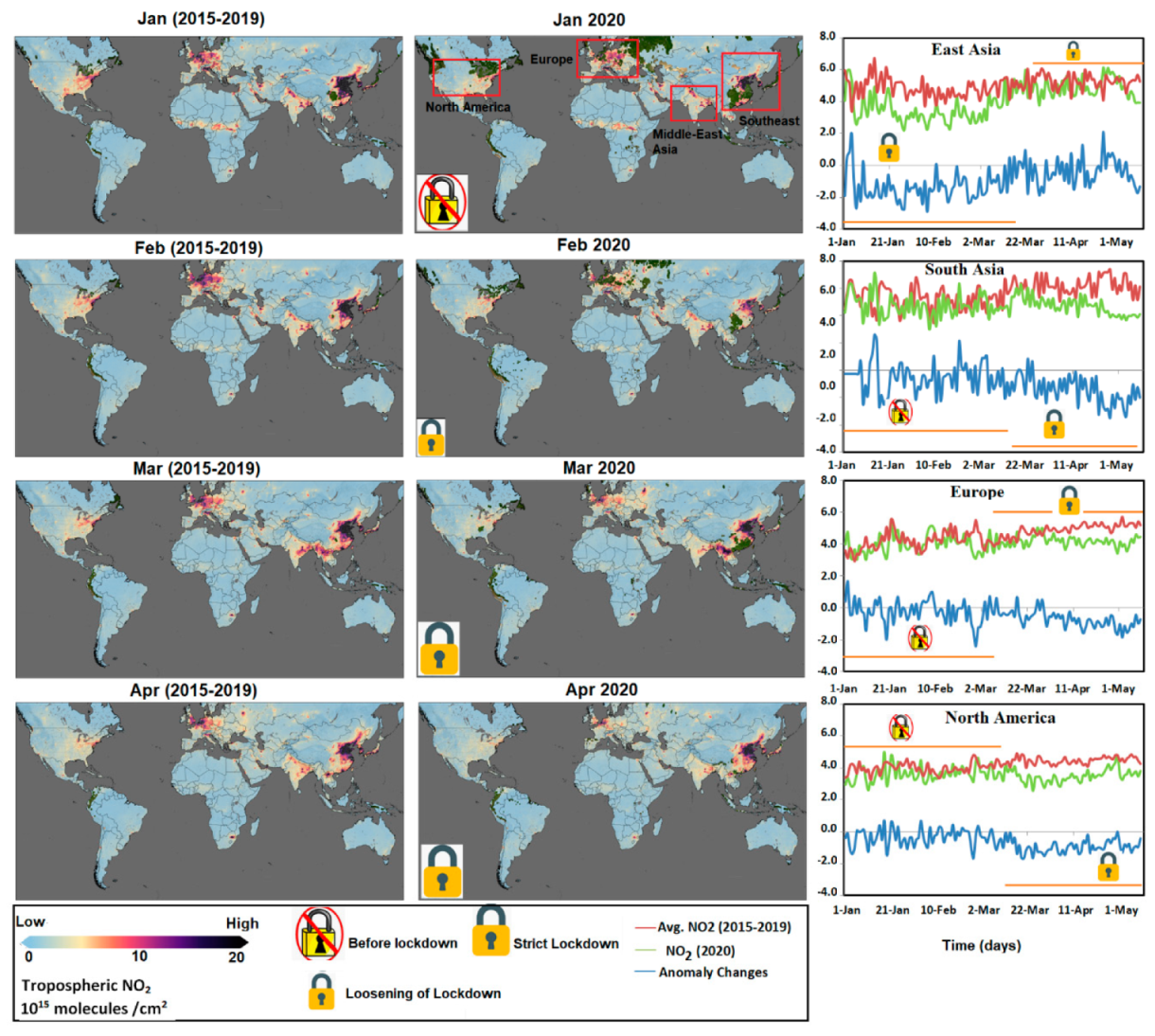


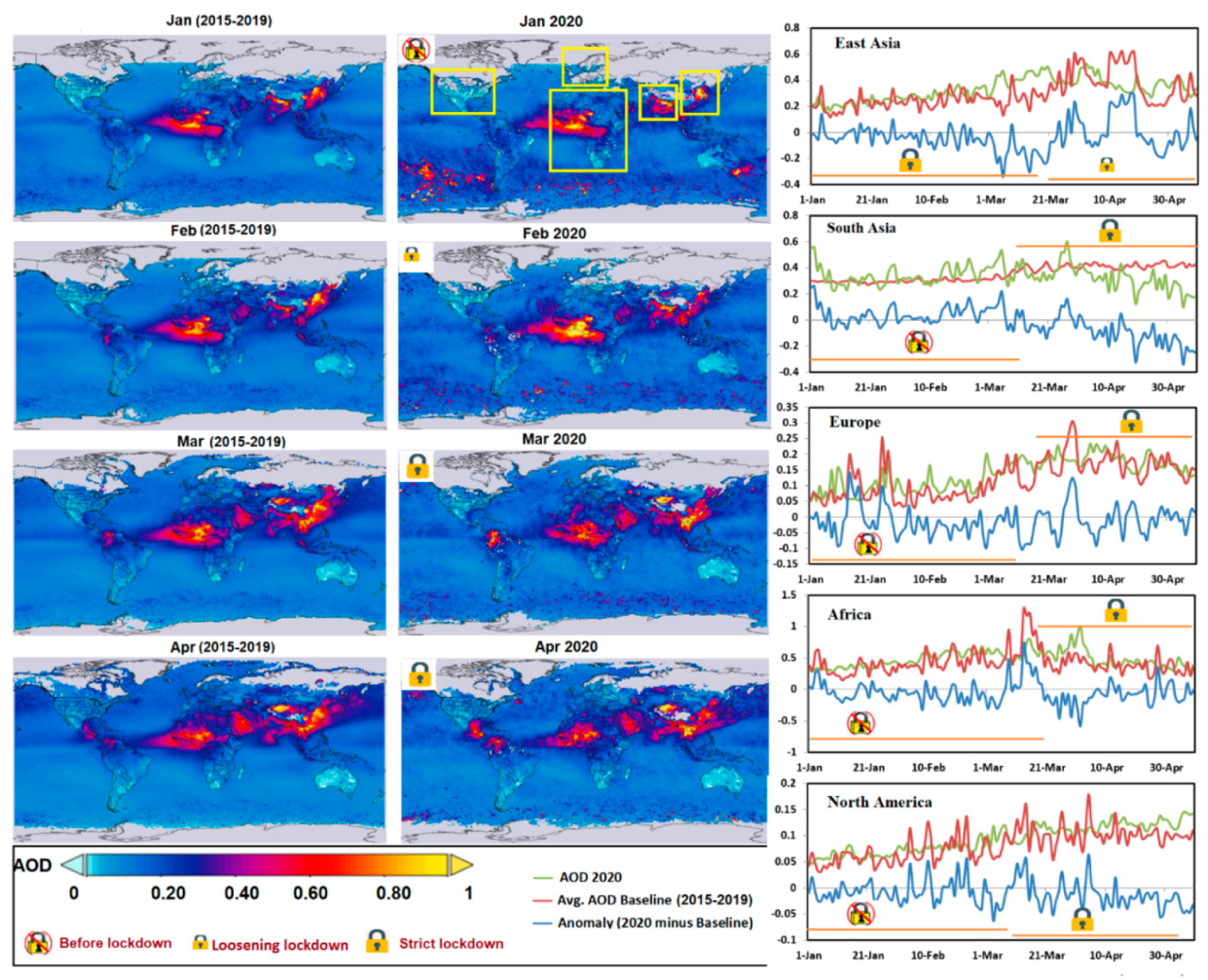

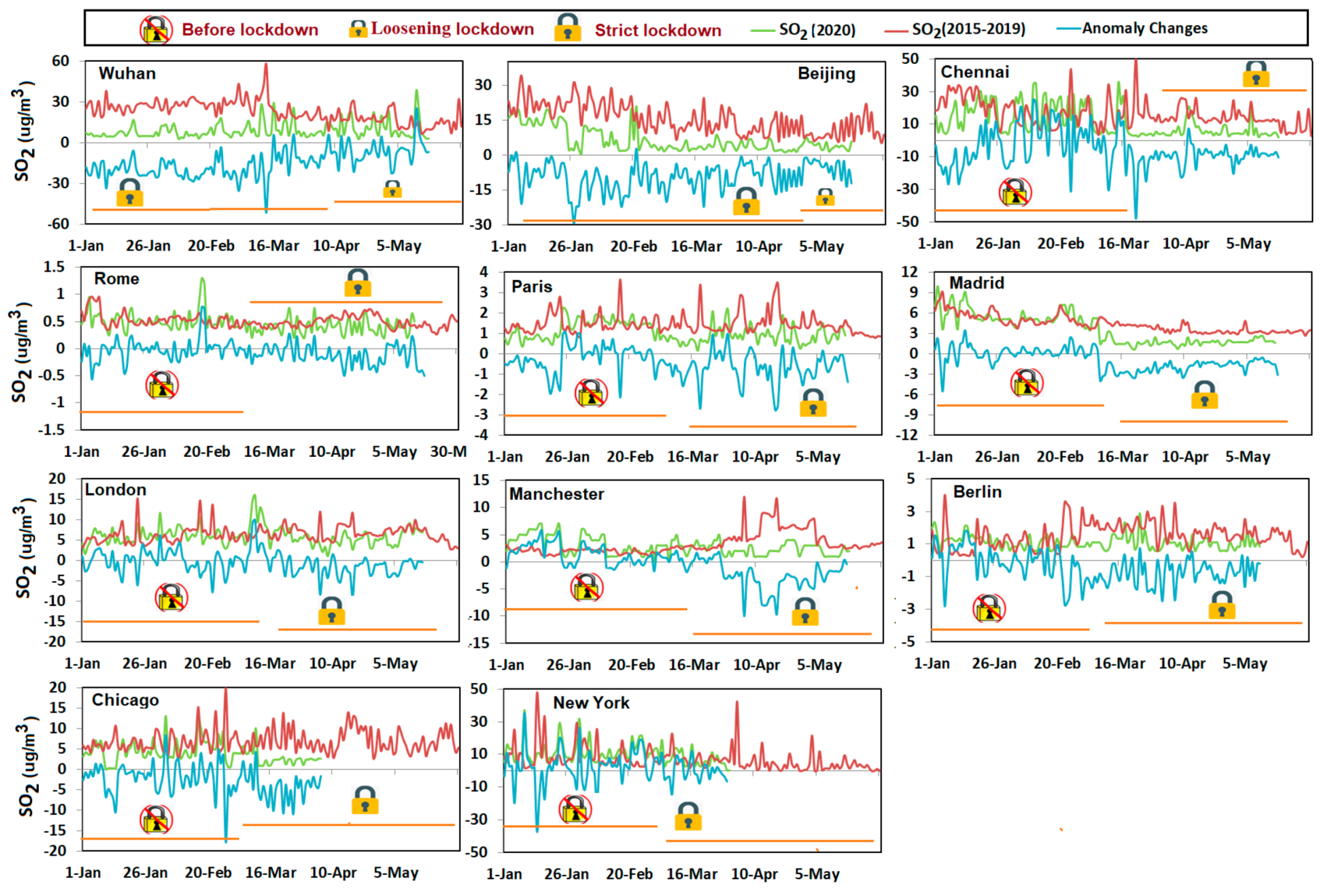
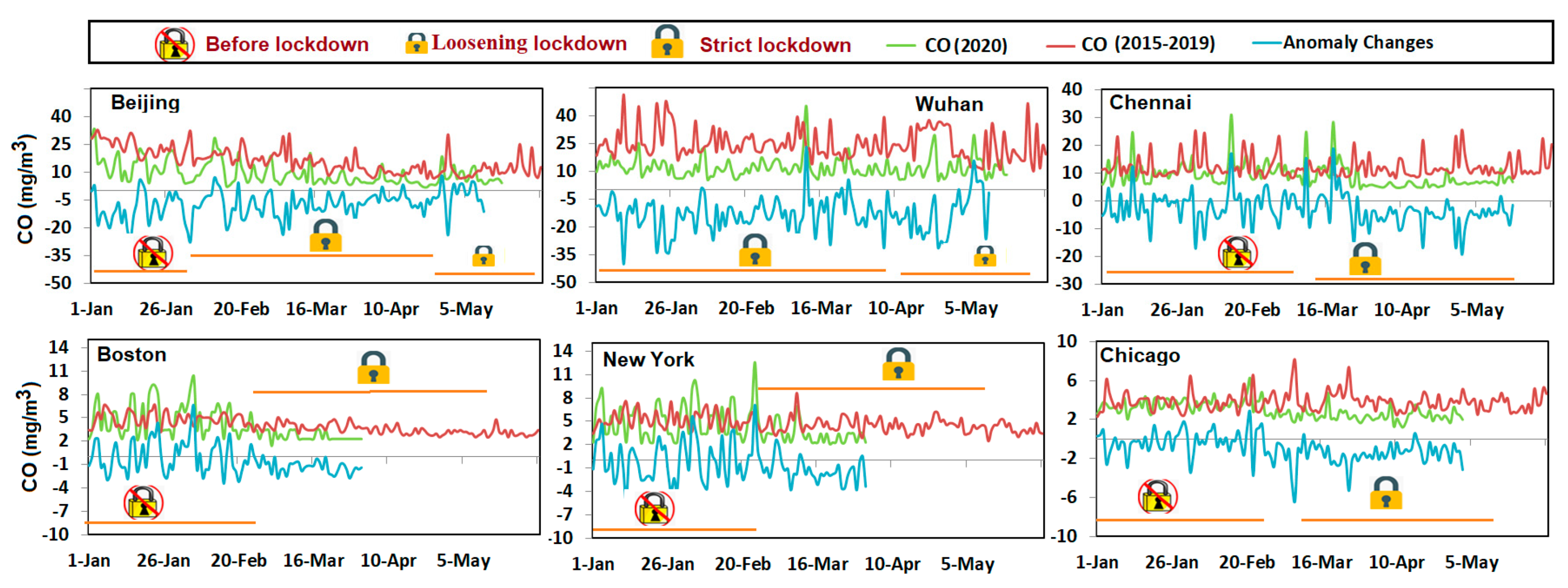
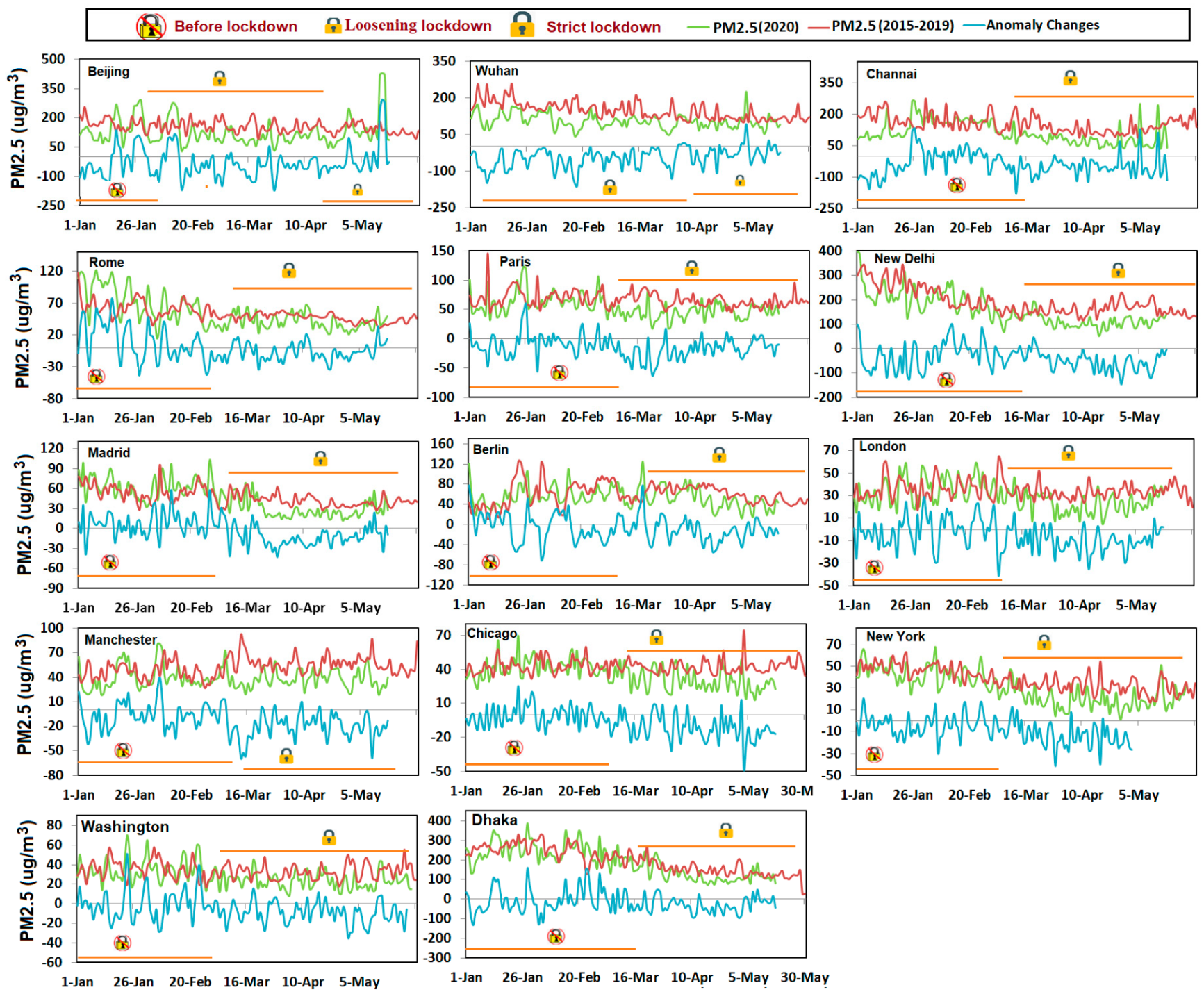
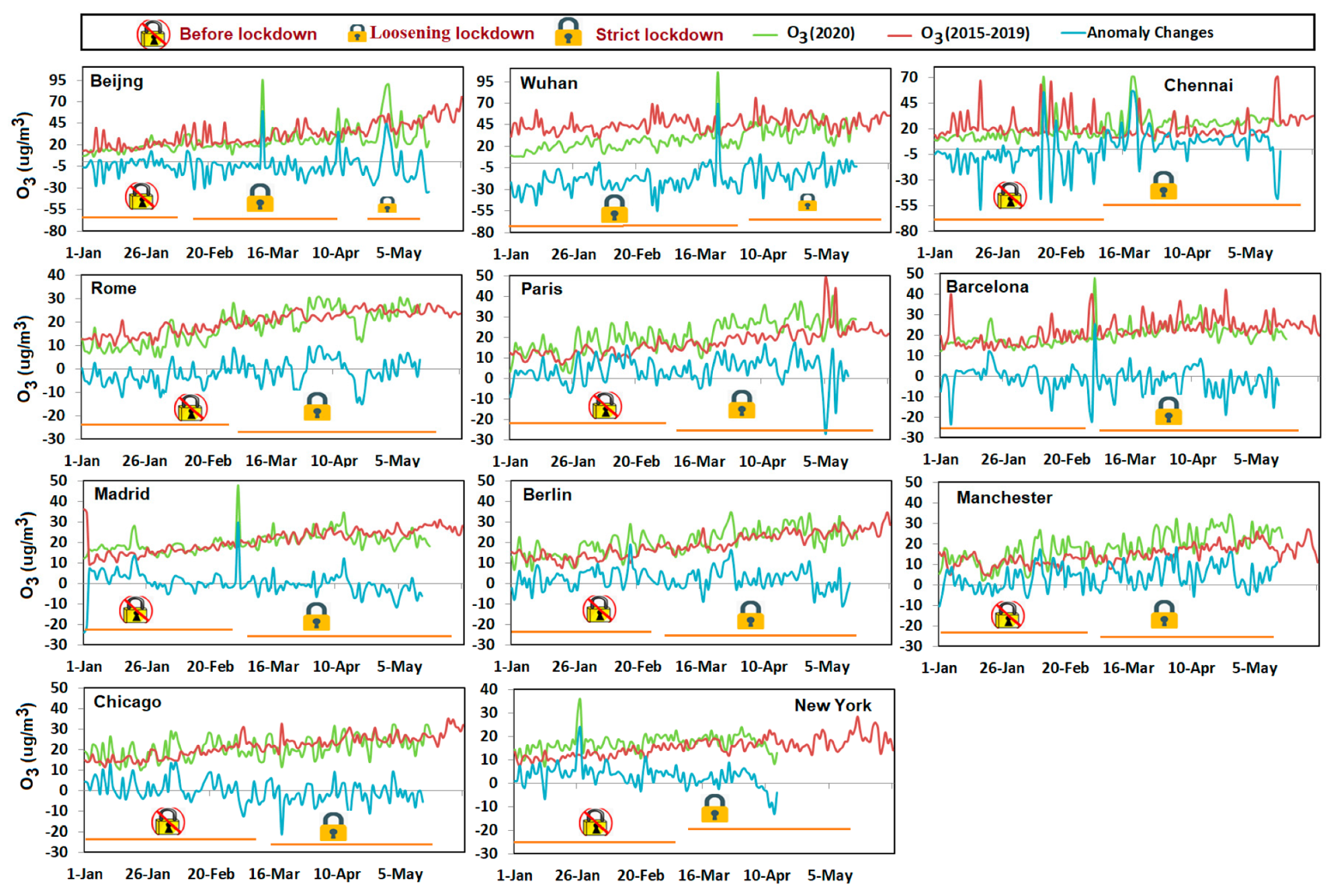
| Scale of Study | Datasets | Spatial Resolution | Temporal Resolution | Acquisition Date | Sensor/ Observations | Data Sources |
|---|---|---|---|---|---|---|
| Continental and Global | NO2, SO2, and O3 | 0.25 × 0.25 | Daily and monthly | 2015–2020 (Jan–Apr) | Ozone monitoring instrument (OMI) | https://disc.gsfc.nasa.gov/datasets/ https://giovanni.gsfc.nasa.gov/giovanni/ |
| Aerosol optical depth (AOD) | 1° × 1° | Daily and monthly | 2015–2020 (Jan–Apr) | Moderate resolution imaging spectroradiometer (MODIS) Terra | https://disc.gsfc.nasa.gov/datasets/ | |
| City scale | NO2, CO, PM2.5, O3, and SO2 | Average over city | Daily | 2015–2020 (Jan–May) | Ground-based | https://aqicn.org/. |
| aqicn.org/data-platform/covid19/ | ||||||
| https://www.epa.gov/outdoor-air-quality-data/ | ||||||
| Country scale | Mobility index | Average over country | Daily | 2020 (Jan–Jun) | Google reports | |
| Country scale | COVID-19 dataset | Average over country | Daily | 2020 (Jan–Jun) | World health organization (WHO) | https://covid19.who.int/ |
| Study Regions | Month | NO2 | AOD | O3 | SO2 | Lockdown Stages |
|---|---|---|---|---|---|---|
| % | % | % | % | |||
| East Asia | Jan | −27.40 | −6.10 | 1.37 | −30.40 | Lockdown |
| Feb | −32.64 | −15.01 | −2.09 | −24.01 | Strict lockdown | |
| Mar | −14.30 | −29.80 | 1.70 | −9.57 | Strict lockdown | |
| Apr | −3.69 | 6.37 | 1.43 | −40.71 | Loosening lockdown | |
| South Asia | Jan | −3.28 | −13.73 | 3.32 | 3.25 | No lockdown |
| Feb | −11.71 | 2.54 | 4.97 | 2.43 | No lockdown | |
| Mar | −12.37 | −0.48 | 4.32 | −3.21 | Lockdown | |
| Apr | −25.28 | −37.17 | 3.38 | −31.65 | Strict lockdown | |
| North America | Jan | −11.05 | −13.20 | 6.44 | 0.79 | No lockdown |
| Feb | −6.38 | −4.40 | 5.55 | 0.98 | No lockdown | |
| Mar | −19.89 | −7.25 | −6.39 | −22.98 | Lockdown | |
| Apr | −29.39 | −12.61 | −9.55 | −35.53 | Strict lockdown | |
| Europe | Jan | −1.39 | 1.33 | 1.83 | 5.49 | No lockdown |
| Feb | −6.23 | −19.18 | −3.36 | −6.50 | No lockdown | |
| Mar | −7.46 | −9.16 | −0.55 | −18.43 | Strict Lockdown | |
| Apr | −26.86 | −9.10 | −10.53 | 3.32 | Lockdown | |
| Africa * | Jan | NA | −9.88 | NA | NA | No lockdown |
| Feb | NA | −16.64 | NA | NA | No lockdown | |
| Mar | NA | −3.91 | NA | NA | Lockdown | |
| Apr | NA | −19.30 | NA | NA | Strict lockdown |
| Cities | Month | NO2 | CO | PM2.5 | SO2 | O3 | Lockdown Status |
|---|---|---|---|---|---|---|---|
| Beijing | Jan–Feb | −26.54 | −32.18 | −16.34 | −37.15 | −18.11 | Loosening lockdown |
| Ma–Apr | −38.88 | −40.12 | −33.19 | −48.18 | −10.79 | Strict lockdown | |
| Wuhan | Jan–Feb | −43.89 | −39.25 | −34.26 | −47.46 | −43.42 | strict lockdown |
| Mar–Apr | −36.86 | −42.45 | −28.83 | −39.85 | −28.21 | Loosening lockdown | |
| New Delhi | Jan–Feb | NA | −10.15 | −7.29 | NA | NA | Before lockdown |
| Mar–Apr | NA | −29.71 | −33.08 | NA | NA | Strict lockdown | |
| Jan–Feb | NA | NA | −1.87 | NA | NA | Before lockdown | |
| Dhaka | Mar–Apr | NA | NA | −19.12 | NA | NA | Strict lockdown |
| Chennai | Jan–Feb | 2.97 | NA | −9.46 | −2.07 | −33.42 | Before lockdown |
| Mar–Apr | −30.62 | NA | −38.19 | −25.96 | 47.13 | Strict lockdown | |
| Rome | Jan–Feb | 3.50 | NA | 14.08 | −2.63 | −24.01 | Before lockdown |
| Mar–Apr | −41.38 | NA | −16.95 | −17.55 | −2.29 | Strict lockdown | |
| Paris | Jan–Feb | −4.91 | NA | −9.85 | −11.94 | 29.58 | Before lockdown |
| Mar–Apr | −32.95 | NA | −31.47 | −41.23 | 30.20 | Strict lockdown | |
| Barcelona | Jan–Feb | −15.04 | NA | NA | NA | −2.59 | Before lockdown |
| Mar–Apr | −44.31 | NA | NA | NA | −8.57 | Strict lockdown | |
| Madrid | Jan–Feb | −9.32 | NA | 15.24 | 4.42 | −19.71 | Before lockdown |
| Mar–Apr | −43.04 | NA | −30.36 | −43.06 | −0.07 | Strict lockdown | |
| Berlin | Jan–Feb | −8.75 | NA | −17.00 | 1.65 | 19.88 | Before lockdown |
| Mar–Apr | −28.44 | NA | −31.87 | −39.11 | 15.15 | Strict lockdown | |
| London | Jan–Feb | 14.99 | NA | 4.26 | −2.45 | NA | Before lockdown |
| Mar–Apr | −49.02 | NA | −29.33 | −5.74 | NA | Strict lockdown | |
| Manchester | Jan–Feb | −8.73 | NA | −6.08 | 12.10 | 24.01 | Before lockdown |
| Mar–Apr | −31.79 | NA | −19.23 | −30.79 | 32.63 | Strict lockdown | |
| Chicago | Jan–Feb | −7.06 | −6.96 | −1.68 | −11.80 | 13.72 | Before lockdown |
| Mar–Apr | −39.36 | −39.07 | −22.46 | −42.17 | −9.94 | Strict lockdown | |
| New York | Jan–Feb | −11.57 | 7.66 | −4.78 | 9.18 | 38.24 | Before lockdown |
| Mar–Apr | −29.00 | −24.70 | −23.45 | −2.70 | 4.17 | Strict lockdown | |
| Boston | Jan–Feb | NA | 2.78 | NA | NA | NA | Before lockdown |
| Mar–Apr | NA | −34.71 | NA | NA | NA | Strict lockdown | |
| Washington | Jan–Feb | 1.9 | NA | 2.43 | NA | NA | Before lockdown |
| Mar–Apr | −33.45 | NA | −21.67 | NA | NA | Strict lockdown |
© 2020 by the authors. Licensee MDPI, Basel, Switzerland. This article is an open access article distributed under the terms and conditions of the Creative Commons Attribution (CC BY) license (http://creativecommons.org/licenses/by/4.0/).
Share and Cite
Zhang, Z.; Arshad, A.; Zhang, C.; Hussain, S.; Li, W. Unprecedented Temporary Reduction in Global Air Pollution Associated with COVID-19 Forced Confinement: A Continental and City Scale Analysis. Remote Sens. 2020, 12, 2420. https://doi.org/10.3390/rs12152420
Zhang Z, Arshad A, Zhang C, Hussain S, Li W. Unprecedented Temporary Reduction in Global Air Pollution Associated with COVID-19 Forced Confinement: A Continental and City Scale Analysis. Remote Sensing. 2020; 12(15):2420. https://doi.org/10.3390/rs12152420
Chicago/Turabian StyleZhang, Zhijie, Arfan Arshad, Chuanrong Zhang, Saddam Hussain, and Weidong Li. 2020. "Unprecedented Temporary Reduction in Global Air Pollution Associated with COVID-19 Forced Confinement: A Continental and City Scale Analysis" Remote Sensing 12, no. 15: 2420. https://doi.org/10.3390/rs12152420






